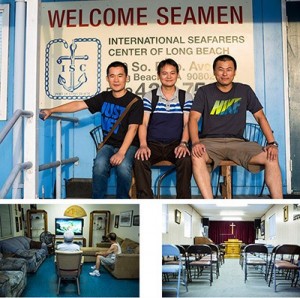Archives
Freight News, Sea
Stepping Up for the Seafarers Center
[ November 3, 2015 // Gary G Burrows ]Within the Port of Long Beach, in the shadow of billions of dollars of new construction, sits an aging bungalow that houses the nonprofit International Seafarers Center (ISC) of Long Beach/Los Angeles.
For the thousands of seafarers who cross its threshold, it is a second home where they can cook fresh meals, do laundry, and connect with family via the Internet.
“One sailor from the Philippines was able to speak at his mother’s memorial service via Skype,” said ISC Manager Pat Pettit, who comes from a family of merchant mariners and has worked at the center since it opened 32 years ago.
Life at sea isn’t easy, said Barry Basel, a radio officer for Matson, who volunteers at the ISC when he is on leave in Long Beach. Crews are away from their families for weeks, maybe months, depending on their tour of duty, and the high seas are an inherently dangerous workplace. That’s why places like the ISC are so important.
Opened in 1983, the ISC started in an old school bus and grew into the 5,315-square-foot amalgamation of modular bungalows it is now. The ISC’s mission is simple: provide a safe place where crews far from home can leave the confines of their ships to relax, refresh, personally prepare a meal and contact loved ones. The center also houses a non-denominational chapel for worship and spiritual support.
While the reception is warm, the structure is less inviting. A rundown kitchen, a leaky roof and a patchwork of balky air conditioners are unmistakable signs of disrepair. So are broken bathroom fixtures, fickle overhead lighting, worn furniture and finances so tight the center must limit its hours of service.
Staying Afloat
The ISC scrapes by on revenues of about $128,000 a year, enough to cover health insurance and what amounts to a modest stipend for the two-person staff, utilities, and gas, insurance and maintenance for the two vans needed to safely shuttle the seafarers between the ISC, their vessels and downtown Long Beach and San Pedro. Lately, only one van has been in working order.
The recent fundraiser, the Maritime Industry Salute and Annual Great Tug Boat Race, is the ISC’s primary source of the funding. A tariff of $35 per vessel call helps, but it is voluntary. The tariff generates about $33,000, approximately one-fourth of the center’s annual income.
The Port of Long Beach provides the land and buildings at no cost. The parcel, about three-quarters of an acre, represents an annual contribution of nearly $80,000. If used for container terminal operations, the value would more than double.
Momentum for upgrading the ISC is growing. In recent days, the center acquired two new vans paid for with a $44,000 donation from the International Transport Workers Federation (ITF), a coalition of trade unions representing various transportation sectors.
More funding is needed to address basic infrastructure needs and secure the ISC’s operating budget going forward. Slangerup has taken the first steps by directing Doug Thiessen, the Port’s Managing Director of Engineering Services, to explore alternate sites for the center within the Port of Long Beach. The current location may no longer be optimal due to its proximity to the Middle Harbor Redevelopment Project, whose new inbound gate opposite the ISC is due to open in early 2016, and ongoing construction of the Gerald Desmond Bridge Replacement Project, which will soon require closure of the ISC’s chapel.
More robust fundraising is needed to secure the ISC’s operational budget. Given that the ISC serves the entire complex, the Port of Los Angeles will also play a crucial role.
“Seafarers play a vital role in the maritime industry and serve as a critical link in the San Pedro Bay supply chain and global trade worldwide,” said Port of Los Angeles Executive Director Gene Seroka. “As a tight-knit industry, we can collectively help this often overlooked population of workers who help deliver successes here at our ports every day.”
Recently, Long Beach Board of Harbor Commissioners President Lori Ann Guzmán toured the ISC. “It’s very impactful to go there and see how frequently it is being used by our seafarers yet how deteriorated the facility has become,” Guzmán said. “It’s all very moving. We need to fix this sooner rather than later.”
Tags: Port of Long Beach, Seafarers Center










